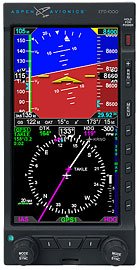| Part #: | |
|---|---|
| Model: | EFD1000 |
| Desc: | Pilot EFD1000 System |
| OEM: | Aspen Avionics |
| NSN: | |
|---|---|
| Sched-B: | 9014208040 |
| ECCN: |
 Select part number above to view pricing and availability.
Select part number above to view pricing and availability.
| Price | Condition | Status | More Info | |
|---|---|---|---|---|
| REQUEST | NEW OUTRIGHT | REQUEST LEAD TIME |
|
| Price | Condition | Status | More Info | |
|---|---|---|---|---|
| REQUEST | NEW OUTRIGHT | REQUEST LEAD TIME |
|
| Price | Condition | Status | More Info | |
|---|---|---|---|---|
| REQUEST | NEW OUTRIGHT | REQUEST LEAD TIME |
|
| Price | Condition | Status | More Info | |
|---|---|---|---|---|
| REQUEST | NEW OUTRIGHT | REQUEST LEAD TIME |
|
- Integral ADAHRS, backup battery and emergency GPS
- Integral altitude alerter/pre-select
- GPS flight plan map views: 360° & Arc
- Slaved directional gyro with heading bug
EFD1000 Pro FEATURES
All the features of the Pilot, plus:
- Full EHSI with dual bearing pointers
- Dual GPS, dual VHF nav support
- Autopilot & flight director integration
- Integral GPS steering
- Base map with curved flight paths
- (optional) Terrain, traffic, weather overlays
SPECIFICATIONS
| Dimensions: | 3.5"W x 7"H x 6.35"D | Weight: | 2.6 lbs (w/mounting bracket) |
| Display Type: | 6.0" Diagonal TFT Active Matrix LCD (400x760) | Display Colors: | 32,768 |
| Face: | Anti-Reflective Coated Glass | Backlight: | High Intensity White LED |
| Rotary Knobs: | Optical Encoder with Momentary Push | Dimming: | Manual & Automatic (Front Bezel Mounted Sensor) |
| Operating Temp: | -20°C to +55°C | Storage Temp: | -55°C to +85°C |
| Max Un-Pressurized Operating: | 35,000 | Cooling: | Integral Fan |
| Max Humidity: | 95% at 50°C | Input Voltage: | +8 to +32VDC |
| Max Current: | 2.4 Amps @ 28VDC, 4.8 Amps @ 14VDC | ||
| ARINC 429 Inputs: | 5 Low Speed | ARINC 429 Outputs: | 1 Low Speed |
| RS-232 Inputs: | 5 | RS-232 Outputs: | 3 |
| Pitot/Static: | Quick Connect | ||
| Technical Standard Order: | TSO-C2d, TSO-C3d, TSO-C4c, TSO-C6d, TSO-C8d, TSO-C10b, TSO-C106, TSO-C113 | Software: | RTCA DO-178B Level C |
| Environmental: | RTCA DO-160E |
| Dimensions: | 2.65"W x 4.40"L x 1"H | Weight: | 0.2 lbs |
| Input Voltage: | Provided by PFD |
| Dimensions: | 5.75"W x 4.30"L x 1.60"H | Weight: | 0.8 lbs |
| Input Voltage: | +10 to +32VDC | Max Current: | 0.5 Amps @ 28VDC 1.0 Amps @ 14VDC |
| Interfaces: | ARINC-429 and RS-232 |
| Part Number: | Description: |
|---|---|
| A-15-120-00 | Pilot System |
| A-15-121-00 | Pro System w/Analog Converter Unit |
| Price | Condition | Status |
|---|---|---|
| REQUEST | NEW OUTRIGHT | REQUEST LEAD TIME |
| Price | Condition | Status |
|---|---|---|
| REQUEST | NEW OUTRIGHT | REQUEST LEAD TIME |
| Price | Condition | Status |
|---|---|---|
| REQUEST | NEW OUTRIGHT | REQUEST LEAD TIME |
| Price | Condition | Status |
|---|---|---|
| REQUEST | NEW OUTRIGHT | REQUEST LEAD TIME |
Click on a question below to see the answer. If you have a question about this model that is not answered below, please contact questions@seaerospace.com
Why do some parts indicate "REQUEST" or “RFQ” on the Southeast Aerospace website?
In relation to NE (New) parts, many OEMs change their prices and availability without any notice to dealers or the industry. Therefore, through the REQUEST or RFQ indication, we ask that customers contact us for the most accurate price and availability.
In relation to SV & OH parts, the used parts aftermarket in the aviation industry is not an infinite supply. It is a dynamic, constantly changing market that is significantly affected by and susceptible to highs and lows in supply and demand. Therefore, although we attempt to, at times, we are unable to predict the exact moment when an item may be available. Once again, through the REQUEST or RFQ indication on our website, we ask that customers contact us for the most current and accurate price and availability.
Will the Evolution Flight Display system work with my VHF navigation radios?
The Pro PFD supports dual VHF navigation radios, whether standalone VHF radios with composite nav outputs, or integrated GPS/Nav receivers.
Will the Evolution Flight Display system work with my current GPS?
All Evolution Flight Display PFDs are designed to work with dual GPS sources that interface through ARINC 429 and/or RS-232.
The GPS Steering (GPSS) function of the Pro PFD is available only when the installed GPS navigator is an ARINC 429-based GPS providing Label 121 bank angle command information (e.g., Garmin 400/500 series GPS navigators).
The EFD system supports both WAAS and legacy GPS navigators. When connected to a WAAS GPS, the Pro PFD will display the Vertical Deviation Indicator (like an ILS glideslope indicator) when an APV (approach with vertical guidance) is loaded and active, and the WAAS GPS is outputting vertical deviation signals to the PFD.
The Pro PFD can also be configured at installation to display the required WAAS GPS annunciations, obviating the need for external annunciators.

